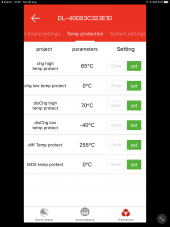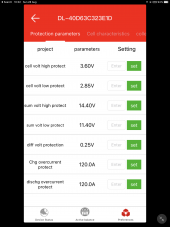derekisastro
New Member
- Joined
- Jan 27, 2021
- Messages
- 77
Sorry for the noob questions ... what is the purpose of the CD4001 you use? Is it necessary?Hallo,
This below is what I have done:
I have a DeliGreen (Daly) 8S 24V Smart BMS, and as always there is only 1 (one) UART port, either for Bluetooth connection (Smartphone application) or for USB serial cable connection (PC application). But, I want to monitor the BMS both wirelessly; using Bluetooth (Smartphone application = SmartBMS), and also wirelessly using WiFi/Internet for PC application (PCMaster).
First step, I built the TTL/UART -to- WiFi Bridge, (Serial -to- TCP/IP). I do not use Raspberry nor Arduino, but there must be a device that works as the TCP Server, here I use ESP8266 module, with the JeeLabs ESP-Link firmware installed. After this setup done, I will have the serial data coming from the BMS, available in the format of TCP/IP, which can be accessed on my WiFi network. Then on my PC, I created a Virtual COM Port, set according to the IP & Port address of the WiFi Bridge. DONE…..!!! At this stage I can monitor the BMS wirelessly via WiFi from my PC, using the PCMaster application. Technically, if I share this port, I can then monitor the BMS via internet, anywhere in this world, (as long as internet is available).
I did not stop here, when I am not working on my PC and just with my smartphone on my hand, and not far away from the BMS (in the Bluetooth signal range), I also want to monitor the BMS via Bluetooth…. So, I also want to connect the Bluetooth dongle to the BMS UART port… BUT, the port has been occupied by the WiFi Bridge…. So, I need to combine this 2 ports from WiFi Bridge and from Bluetooth dongle, to be connected into 1 port of the BMS UART port.
Second step, I built a port combiner, the task of this combiner is to combine the Tx from WiFi Bridge and Tx from Bluetooth dongle, into a single Tx going to the BMS Rx. While the Tx from the BMS can be shared to the Rx of WiFi Bridge and Rx of the Bluetooth dongle. I built this combiner using 3 NOR Gates of the Quad NOR Gate IC, CD4001. DONE….!!! At this stage I can monitor the BMS wirelessly via WiFi and via Bluetooth…
Still, I do not stop here, now I am decoding the serial data coming from the BMS, and will integrate them into my Node-RED, and this will be presented on the same User Interface as my other IoT stuff running now on the Node-RED… So, I only need to open the Node-RED user interface, and I can monitor & control all my IoT devices, including this BMS, anywhere in this world (again, as long as internet is available).
Attached some pictures of my simple hardware, only has 3 main components, (ESP8266, CD4001, and DC-DC Converter)… Sorry for the quick, dirty and ugly of my hand scratch of the diagram, but you can grab the idea from that….
Regards,
Antonius
Is there any way, even just for monitoring the system/BMS to connect the UART to an ESP device using your system?
I am hoping to monitor it with Home Assistant.




